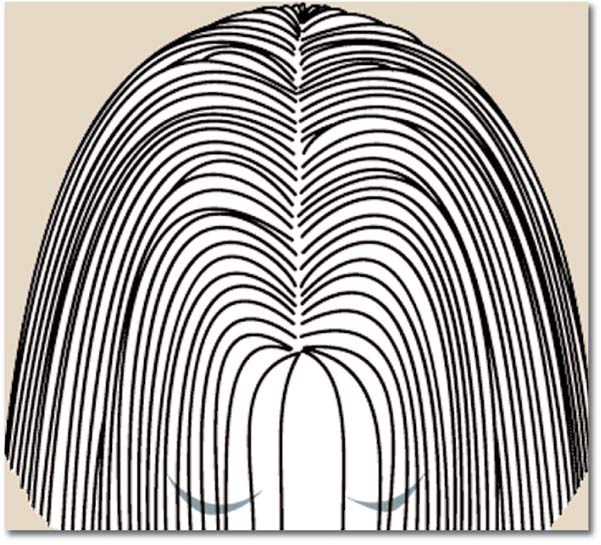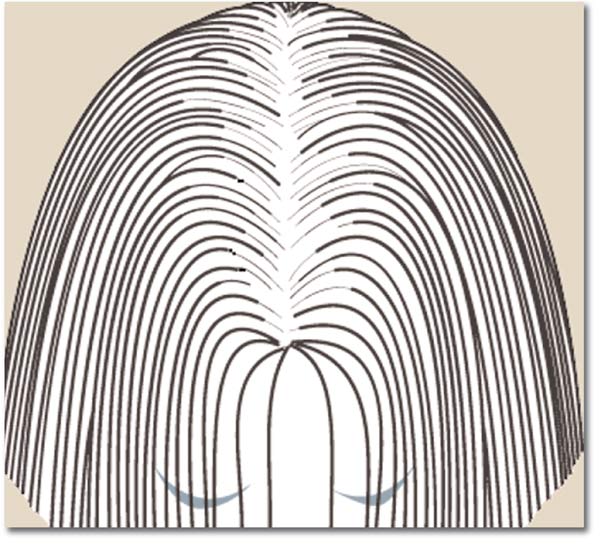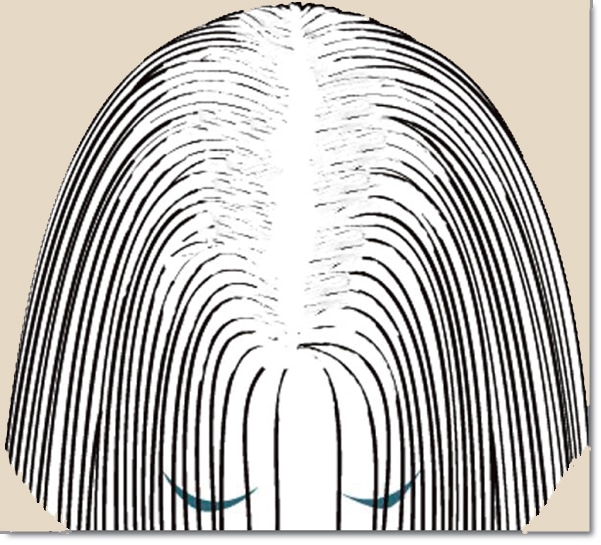Baldness is affecting more and more women, especially younger and younger women. It is estimated that one in two women will experience alopecia at some point in their lives. As a result, many doctors and dermatologists are increasingly faced with questions from their patients about baldness. Practitioners are often at a loss when faced with the distress of women who notice a sudden loss of hair and believe they are suffering from a serious illness. Today, science does not yet know why baldness develops. However, we often observe hair loss in women during major hormonal changes: pregnancy, childbirth, peri-menopause.
What causes baldness in women?
More than 9 times out of 10, female alopecia is of the androgenetic type, therefore of hormonal origin. Please note that this does not mean that women who suffer from baldness have a hormonal imbalance. Androgenetic alopecia is in no way a disease and in no way a hormonal disease. It is simply a sign that their hair follicles are sensitive to the activity of male hormones.
In women, male hormones are produced by the adrenal glands (60%) and the ovaries (40%), albeit in much smaller quantities than in men (around 20 times less). These hormones then diffuse through the body via the bloodstream. At this stage, everything is normal. When these male hormones arrive near the hair follicles, they are broken down into dihydrotestosterone (DHT) by an enzyme called 5-alpha reductase. This metabolism is also completely normal and does not in itself explain female pattern baldness.
From there, 2 possibilities depending on the presence or absence of DHT receptors in the hair follicle. The receptors are, in a way, "windows". If there are windows, and therefore receptors, the DHT can 'enter' the hair follicle.
If there are no windows, the DHT will not be able to enter. So :
- 1. If DHT cannot "enter" the hair follicle, nothing happens. The life cycle of hair proceeds normally, from the anagen phase to the telogen phase ; every hair that falls out is naturally replaced by an equally strong hair than the one it replaces and no baldness or weakening of the hair mass will be observed. Each hair grows back according to its life cycle Hair growth follows an immutable phase.
- 2. However, if DHT can enter the hair follicle, problems arise. DHT disrupts the activity of the proteins that regulate the hair's life cycle. The hair's life cycle will spiral out of control, hair loss will occur prematurely, and the hair that does fall out will be replaced by hair that is thinner and thinner until it doesn't grow back at all.
Baldness in both men and women is certainly hormone-dependent, but contrary to popular belief, it is not, female baldness is not a symptom of hormonal imbalanceBaldness is not the result of a hormonal disease or disorder. Baldness is simply explained by the presence or absence of DHT receptors in the hair follicles. It is this localised dysfunction that causes abnormal hair loss.
Will I go completely bald? is a fear expressed by many women when they consult their doctor. But rest assured, apart from rare cases - such as certain illnesses like alopecia (partial or total), an auto-immune disease that leaves the skin completely hairless, causing hair loss and even the loss of all body hair - total alopecia in women is extremely rare.
Unlike in men, female pattern baldness develops very slowly and women who suffer from it do not go completely bald. But, unfortunately, severe alopecia is less severe and often occurs early. In fact, when the onset of alopecia affects a young woman, it progresses more rapidly and it only takes a few years for the young woman to notice a visible loss of hair, a head of hair that gradually thins out without any good quality regrowth.



In women, alopecia appears in a diffuse form, localised on the top of the head and on the sides. More rarely, alopecia in women also affects the temples and forehead area. Finally, contrary to popular belief, androgenetic alopecia is not always the result of a disease. hereditary. This is often a source of incomprehension for a young woman who sees her head receding, who notices a loss of hair mass, when no one else in her family suffers from this disorder.
Other causes of alopecia in women are much rarer. There are, of course, drug treatments, chief among them certain chemotherapies. There are also seasonal falls or falls after childbirth. Unlike androgenetic alopecia, hair loss resulting from medication and so-called post-partum hair loss are more of the telogen effluvium type, i.e. diffuse hair loss spread evenly over the entire skull. Most of these cases of hair loss in women disappear rapidly, without the need for anti-hair loss treatment, and do not progress to permanent baldness.
What factors aggravate female baldness?
Stress
Stress has the effect of stimulates the activity of the adrenal glands (which produce 60% of male hormones in women), and therefore the production of androgen hormones, and therefore the production of DHT, which will ultimately attack the proteins regulating the hair life cycle and thus encourage the unfavourable development of alopecia in women.
The thyroid gland
This gland produces thyroid hormones, which regulate all the body's metabolic processes. Its role is therefore absolutely central, and it is essential to act quickly if certain disorders or symptoms appear (cf hair loss and thyroid). If it produces too many hormones, this is called hyperthyroidism. If it doesn't produce enough, it's called hypothyroidism. In either case, there are very often negative consequences for the life of the hair, so baldness accelerates. In most cases, appropriate medical treatment will regulate the thyroid imbalance over the long term, without too many damaging consequences for the hair.
Deficiencies
Numerous deficiencies can have a negative impact on hair life and aggravate baldness. B vitamins, vitamin C and zinc are often cited. However, our experience shows that two deficiencies in particular clearly accelerate baldness in women: iron deficiency and vitamin D deficiency.
Iron deficiency
An iron deficiency most often leads to worsening of female alopecia. Iron plays an essential role in the metabolism of red blood cells, one of the functions of which is to distribute the oxygen produced by the lungs to the cells. However, due to menstrual loss and pregnancy in particular, women are much more likely to be iron deficient than men.
With less oxygen, the basal cells of the hair will find it much harder to duplicate themselves to produce keratin. An iron deficiency will therefore have a very negative effect on hair growth and alopecia. You can find iron-rich foods on the website of the Agence Nationale de la Sécurité Sanitaire, de l'alimentation de l'environnement et du travail (ANSES). Doctors can also prescribe supplementation for a few months.
Vitamin D deficiency
Vitamin D deficiency causes premature ageing of hair follicles, resulting in hair loss and poorer renewal of the hair that does fall out. Vitamin D deficiency is therefore a friend of baldness and an enemy of healthy hair!
Vitamin D is either synthesised by the body under the effect of the sun, or provided by the diet. So people who are less exposed than others to the sun's rays (winter, people who don't go out much) will be more likely to develop a significant deficiency, which will have a direct effect on the development of baldness. Of course, it is possible to make up for this deficiency by eating a diet rich in vitamin D. We invite you to consult the website of the Agence Nationale de la Sécurité Sanitaire, de l'alimentation de l'environnement et du travail (ANSES) to find out which foods are rich in vitamin D.
What solutions are there to combat alopecia? What are the various effective treatments for female pattern baldness?
Medicines
To combat female alopecia, doctors mainly recommend MinoxidilMinoxidil has been available in France without a prescription since January 2012. Minoxidil was originally a vasodilator developed in the 1990s to help combat high blood pressure. Patients taking this molecule noted side effects on the hair system. On the face of it, this was good news for those suffering from alopecia.
But the problem was that hair growth did not just increase on the scalp, but all over the body (growth of hair on the face, back, buttocks, etc.), which was less good news, particularly for women. The researchers therefore prepared this molecule in topical form (applied directly to the scalp) to check whether the molecule administered in this way had any effect on hair growth. Studies showed that it did, and Minoxidil was born.
Its use is not without constraints: it has to be applied every day, or even twice a day, and the alopecia returns as soon as you stop applying it. At Clauderer, we have also observed a "plateau effect" in some of the people we support after around 3 years of application, as if the scalp were reacting less and less to the active Minoxidil molecule.
Clauderer serums: a natural and effective treatment
Every year, thousands of women suffering from alopecia call on our expertise. The success of our treatments is based on both a personalised protocol and a range of exclusive products (Clauderer serums in particular) which will help them to overcome their alopecia problem.
Hair transplants
Hair transplant techniques have come a long way and, when performed by a good surgeon, are considered to be the last resort in cases of female pattern baldness. Today, there are 2 main techniques: the FUT (Follicular Unit Transplantation) the FUE (Follicular Unit Excision).
The first consists of removing a "strip" of scalp from an area not affected by baldness, cutting out groups of follicles under a microscope and re-implanting these hairs in the affected areas. The second involves "incising" to remove hair by hair and re-implanting hair by hair in areas suffering from alopecia.
Each grafting method has its advantages and disadvantages (possibility of grafting more hair with the first, only micro scars for the second) but overall, these techniques have a cost that is not negligible (between 5,000 and 8,000 Euros).
Other methods
The main ones are semi-permanent tattooing of the scalp (which reduces the visibility of the skin of the skull lacking hair), mesotherapy, PRP... and others. At Clauderer, we have not seen any significant improvement in female baldness using these techniques.
Answers to your questions about female pattern baldness
Can women go bald?
Baldness is increasingly common among women, and is affecting younger and younger women. In 9 out of 10 cases, it is androgenetic in origin. In practice, the male hormones produced by the adrenal glands and ovaries cause the hair's life cycle to spiral out of control: it grows thinner and thinner, for shorter and shorter periods, and eventually stops growing at all.
How can I tell if I'm suffering from alopecia?
There are four signs that always accompany baldness in women:
1. There is a gradual thinning of the hair. If you find your hair more difficult to manage, this is a warning sign.
2. Alopecia is always progressive: hair loss is not massive in women.
3. Baldness primarily affects the top of the head and the sides. The frontal area is less common.
4. When alopecia occurs, it is always long-lasting. The process never goes away on its own. Treatment is essential to halt the deterioration.
What causes hair loss in women?
Hair loss can have many causes. Hormonal changes, such as a change in the contraceptive pill, childbirth or the menopause. There is also hair loss linked to stress or certain deficiencies (mainly iron and vitamin D). Finally, there are seasonal falls (spring and autumn). Fortunately, most falls stop on their own. If it lasts for more than 4 months, you should seek medical advice.

